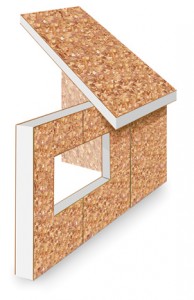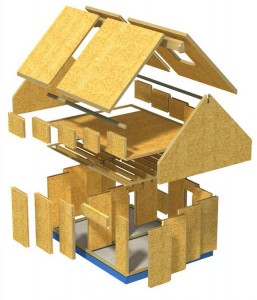What Are Structural Insulated Panels (SIPs)?
Structural Insulated Panels (SIPs)
 A reader asked me the other day to explain what’s the difference between Structural Insulated Panels and Prefabricated Wall Panels. Before answering the question on the difference it is important to answer the of: What Are Structural Insulated Panels or SIPs?
A reader asked me the other day to explain what’s the difference between Structural Insulated Panels and Prefabricated Wall Panels. Before answering the question on the difference it is important to answer the of: What Are Structural Insulated Panels or SIPs?
Structural insulated panels (or structural insulating panels), SIPs, are a composite building material. They consist of a sandwich of two layers of structural board with an insulating layer of foam in between. The board can be sheet metal or oriented strand board (OSB) and the foam either expanded polystyrene foam (EPS), extruded polystyrene foam (XPS) or polyurethane foam.
SIPs share the same structural properties as an I-beam or I-column. The rigid insulation core of the SIP performs as a web, while the OSB sheathing exhibits the same properties as the flanges. SIPs replace several components of conventional building such as studs and joists, insulation, vapor barrier and air barrier. As such they can be used for many different applications such as exterior wall, roof, floor and foundation systems. – Ref: Wikipedia
To the average person SIPs might seem like a very “un-structural” building component. Actually SIP’s are an extremely efficient structural member that relies on diaphragm action and beam theory which allows for continuous super efficient insulating. As a structural engineer I smile with envy wishing I had been the one to develop the method.
Similarities To Prefabricated Wall Panels
 There are two similarities between structural insulated panels and prefabricated walls panels. First of all both are manufactured inside a factory building out of the weather and elements under a controlled environment. Secondly, both systems are erected on-site with a small crane in a rather short period of time compared to traditional framing methods.
There are two similarities between structural insulated panels and prefabricated walls panels. First of all both are manufactured inside a factory building out of the weather and elements under a controlled environment. Secondly, both systems are erected on-site with a small crane in a rather short period of time compared to traditional framing methods.
Benefits of Structural Insulated Panels
SIPs offer many advantages and benefits over traditional “stick” framing practices. Some of the benefits include:
- Better Insulation Values – SIPs built with XEPS foam have an R value of 4 to 5 per inch of foam insulation. A typical 5.5 inch wall (comparable to 2×6) has an R value of 22 compared to an R of 19 for a fiberglass wall (R 19 for fiberglass is actually impossible due imperfect installation and studs).
- Better Building Envelope – SIPs offer a much “tighter” building envelope which results in fewer drafts and better energy efficiency.
- Faster On-Site Construction Time – SIPs are much faster to erect on-site compared to traditional framing. Panels are typically manufactured in 4 foot wide by 8 foot to 24 foot long sections. Because the panels are so large and already insulated the project schedule on-site is reduced drastically. This is especially beneficial in areas with poor weather conditions.
Drawbacks of Structural Insulated Panels (SIPs)
As is true with most any thing in life SIPs do have some drawbacks including:
- Chemicals – There are concerns within the construction industry that chemicals from the interior layers of OSB may create an off gassing problem inside the home. This may be especially true due to improved “tightness”. Just be sure to specify formaldehyde-free OSB panels.
- Plumbing and Electrical – Plumbing and electrical chases must be pre-drilled in the factory. Because of this changes in the field can be time consuming and expensive.
- Fire – In the event of a fire the foam core of SIPs can catch fire and melt rapidly resulting in a catastrophic structural failure. It’s extremely important that fire rated drywall be used on the inside of the home to protect structural capacity for a sufficient amount of time to allow escape from the building in the event of a fire.
Bottom Line on SIPs
The bottom line on SIPs is encouraging. Although the initial cost of them may be slightly higher the long term costs are certainly lower. It’s also likely that a comparison of SIP vs Stick Built homes would results in very similar pricing. The fact is clear that the improved energy efficiency combined with the speed of construction will push the SIP market in the comming years. I’m certain that the SIP industry will continue to develop the product and increase it’s market share.
Image #1 Credit: Foam Laminates of VT
Image #2 Credit: SIP Supply


















I have had the opportunity to work on several SIP projects in recent years.
They do require careful planning, but so does any good construction project.
The easy of heating was incredible. I firmly believe that this system of building will gain in popularity in leaps and bounds in the years to come.
We looked at SIPs, but instead opted to use a foamed concrete block filled with concrete. So far, the insulation values is amazing. During the build this summer, the ONLY place in the house that EVER got hot, was the third floor, that had regular framing and, at that time, no insulation at all. The rest of the house — with NO AC — was completely comfortable.
I can’t wait to see our AC bill next summer. :)
Alison – I’m very excited to hear all about your winter and summer experience in your new home. Pretty cool! I’m also looking forward to seeing pictures from the finished home!
Todd, I’m looking forward to your article on “what’s the difference between Structural Insulated Panels and Prefabricated Wall Panels” where you contrast the costs and benefits of each. As for Allison’s ICFs, I have found ICFs to be several times more expensive than SIPs with no significant benefits.
My friend has been looking into more insulation for his basement because it gets so cold in the winter. I’m glad you stress the importance of fire rated drywall because that has been a huge concern of his. I will pass along this information to him! Thanks for the help!
A neighbor down the street had a massive house built with these panels. It looked great and everything went up fast but after about 15 years he had a fire and since there was no real structural integrity to the house once some of the internal walls were damaged the entire house had to be torn down. This time he did a stick build. House looks exactly the same as it did but now if he has another fire maybe it won’t have to all be torn down.
From my experience….once you have a fire….not much is worth saving due to the smell and water damage…just my 2 cents :)